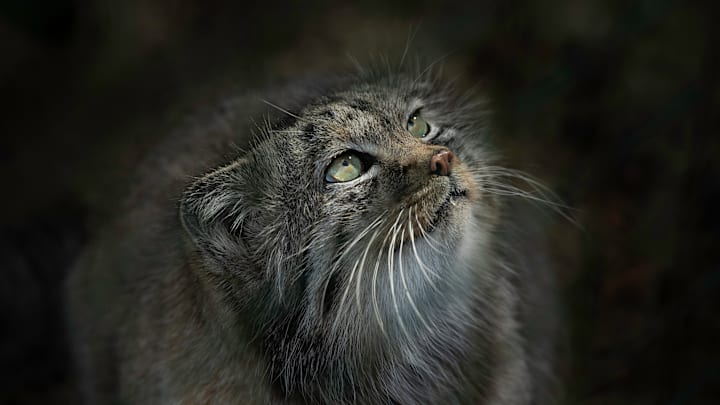Far across the world, an elusive—and adorable—wildcat called the Pallas’s cat (also known as the manul) roams the grasslands and steppes of Central Asia and Eurasia. Here’s what you need to know the flat-faced, furry kitty.
1. It’s named after naturalist Peter Pallas.
German naturalist Peter Pallas first described the furry wildcat in 1776. He named the kitty Felis manul, and theorized that it was an ancestor of the Persian cat, due to its round face, luxurious coat, and stocky body. (He was wrong.)
2. Its scientific name means “ugly-eared.”
Later on, the cat’s scientific name was changed from Felis manul to Otocolobus manul—not exactly the most flattering moniker, since Otocolobus is Greek for “ugly-eared.”
3. The Pallas’s cat’s unusual ears come in handy.
The Pallas’s cat’s round ears—which sit flat on the sides of its head—are one of the feline’s most distinguishing features. As Crystal DiMiceli, a former wild animal keeper at Brooklyn’s Prospect Park Zoo, explains in the above video, having low-positioned ears helps the cat conceal itself—they don’t poke up to reveal the animal’s position while it’s hiding or hunting.
4. It has a dense, plush coat.
The coat of the Pallas’s cat is its true crowning glory. It’s longer and denser than any other coat belonging to a member of the Felid species (growing in even heavier in the winter), and the undercoat on its belly is twice as long as the fur covering the rest of its body. The shade ranges from silvery grey during the winter to a darker, red-toned hue during warmer months. (Some cats are also red, particularly in Central Asia.) Its broad head is streaked and speckled with dark markings, and its bushy tail is banded with stripes and a dark tip. These markings tend to appear darker during the summer.
5. The Pallas’s cat’s fur blends with its habitat, which conceals it from predators.
Pallas’s cats live in areas ranging from Pakistan and northern India to central China, Mongolia, and southern Russia. According to Wild Cats of the World by Luke Hunter, its body isn’t adapted for snow, so it sticks to cold, arid habitats—particularly grassy or rocky areas, which help conceal it from predators—at elevations of around 1500 to nearly 17,000 feet. The stocky cat isn’t a fast runner, so when it senses danger, it freezes and crouches flat and motionless on the ground, and its fur helps it blend in with its surroundings.
6. Pallas’s cats aren’t fat—they’re just furry.
Pallas’s cats typically weigh less than 12 pounds, and they’re usually only 2 feet or less in body length—meaning they’re not that much larger than an ordinary house cat. Yet their dense coat of fur makes them appear much larger.
7. Their pupils are round instead of vertical.

Pallas’s cats do share one feature in common with larger wildcats, like lions and tigers: their eyes. Their pupils are round, whereas a house cat’s pupils are vertical and slit-shaped. Wondering why some cats have round pupils while others have vertical ones? A 2015 study conducted by researchers at the University of California, Berkeley found that animals’ pupil shapes might indicate their role in the predator/prey food chain. They analyzed 214 species of land animals (including cats), and noted that species with vertical pupils tended to be ambush predators that were active during both day and night.
In contrast, species with round pupils were often “active foragers,” meaning they chase their prey. Also, predators that are closer to the ground, like house cats, were prone to vertical pupils, whereas larger wildcats had round ones. Pallas’s cats are small, and they are primarily ambush hunters, so the jury’s still out on whether the study’s findings hold true for all creatures.
8. They subsist mostly on pika.
Pallas’s cats are ambush hunters and spend much of their time hunting pika, a small mammal, and other critters like gerbils, voles, hares, ground squirrels, birds, and young marmots. Pika typically make up more than 50 percent of the cat’s diet.
9. Pallas’s cats may be distantly related to the leopard cat.
Peter Pallas may have thought the animal was related to the Persian cat, but experts have uncovered evidence that the wildcat’s nearest—yet still pretty distant—relative might be the leopard cat.
10. They’re not social animals.

The Pallas’s cat is notoriously elusive and spends much of its time hiding in caves, crevices, or abandoned burrows.
11. They don’t seem to like each other much.
Pallas’s cats may be adorably fluffy, but they aren’t the world’s sweetest, most cuddly creatures. In fact, they’re very aggressive. Case in point: In The Wild Cat Book, authors Fiona and Mel Sunquist recount an anecdote provided by Bill Swanson, the Cincinnati Zoo’s director of animal research. Zookeepers thought that a litter of newborn Pallas’s cats were having difficulty breathing, but “when they listened closely, they realized that the noise they were hearing was the kittens growling and hissing at each other—before they had even opened their eyes!”
12. Their mating period is brief.

Pallas’s cats mate between December and March; the females typically give birth between the end of March and May after a gestation period of 66 to 75 days. Pallas’s cats usually give birth to three or four kittens, but litters can sometimes have as many as eight kittens. Kittens become independent by four to five months, and when they reach nine to 10 months, they’re mature enough to reproduce.
A version of this story ran in 2017; it has been updated for 2023.
